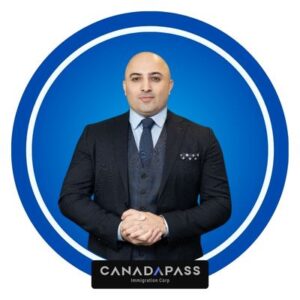Canada, known for its diversity and opportunities, introduced the Canada Express Entry system in 2015 to simplify immigration for skilled workers. This online system manages applications for three economic programs:
- Federal Skilled Worker Program
- Federal Skilled Trades Program
- Canadian Experience Class
Canada Express Entry offers a fast, efficient, and transparent pathway to permanent residency for professionals, tradespeople, and those with Canadian work experience. This article covers eligibility, application steps, and strategies to improve your Comprehensive Ranking System (CRS) score, helping you turn your dream of living in Canada into reality.
Canada Express Entry Immigration Programs
The Canada Express Entry system is designed to facilitate immigration for skilled individuals who wish to contribute to Canada’s economy. It manages applications for three main programs, each targeting specific categories of applicants with varying qualifications and work experience. Here’s a detailed look at each program:
1. The Canadian Experience Class (CEC) Program
The CEC is ideal for individuals with recent Canadian work experience. To qualify, you must have:
- Work Experience: At least one year of skilled work experience in Canada within the last three years before applying.
- NOC Categories: Your work experience must align with one of these National Occupation Classification (NOC) categories:
- Skill Type 0: Managerial positions (e.g., marketing managers, project managers).
- Skill Level A: Professional roles requiring a degree (e.g., doctors, engineers, architects).
- Skill Level B: Technical or skilled trades jobs (e.g., electricians, chefs, welders).
2. Federal Skilled Worker (FSW) Program
- If you meet the FSW requirements (e.g., minimum 67 points on the selection grid, language proficiency, and work experience in NOC 0, A, or B), you can still apply, even if your work experience was outside of Canada.
- Being in Canada at the time of application can provide additional advantages, such as better access to settlement services.
3. Federal Skilled Trades (FST) Program
Skilled workers in certain trade occupations who are already working in Canada can use this pathway if they have a valid job offer or a certificate of qualification issued by a Canadian authority.
Note: Many international graduates in Canada gain skilled work experience and qualify under the CEC or FSW programs.
Steps to Apply for Express Entry
- Evaluate your eligibility
- Prepare Your Documents
- Create Your Express Entry Profile
- Enter the Express Entry Pool
- Submit Your Application After Receiving an ITA
Costs of Express Entry
Express Entry is the most cost-effective and fastest way to obtain Canadian permanent residency, but it’s not free. You are required to pay certain fees, which vary based on factors like applying individually or with family, your country of residence, and the number of language tests you take.
Below is a table listing the latest approximate costs for Express Entry applicants:
Cost Type | Cost Amount |
Language Test | Approximately $300 |
Educational Credential Assessment (ECA) | Approximately $200 |
Biometrics | $85 per person or $170 per family (two or more people) |
Government Fees (Application Processing) | $1,525 per adult and $260 per child |
Medical Examination | $200 to $450 |
Police Clearance Certificate | Approximately $100 per person |
In this system, uploading original documents is crucial, and there’s no need to provide physical copies. Also, ensure that all documents are translated into English or French, including a translator’s certificate and certified copies of the original documents.
Required Documents for Express Entry Canada
- Identity Documents: Valid passport, Birth certificate and national ID, Recent photo meeting official requirements, Marriage certificate (if married) or divorce certificate (if applicable) and Identity documents for your spouse and children.
- Language Documents: Upload official test results for English (IELTS General or CELPIP) or French (TEF or TCF) language proficiency.
- Educational Documents: Verified educational credentials for you and your spouse (if applicable) through an Educational Credential Assessment (ECA) from an approved agency like WES. Upload all relevant diplomas, degrees, and transcripts.
- Work Experience Documents: Official letters from previous employers outlining your job roles, duties, and duration of employment. Insurance records to validate your employment history (if applicable). A valid job offer from a Canadian employer, if you have one, as it can significantly enhance your CRS score.
- Proof of Funds: For applicants under the Federal Skilled Worker Program (FSWP) and Federal Skilled Trades Program (FSTP), submit: A bank letter confirming your account details and Recent bank statements demonstrating sufficient funds to support yourself and your family in Canada.
The latest updated information from the Immigration, Refugees and Citizenship Canada (IRCC) website, as of June 2024, is shown in the table below.
Family Size | Required Funds (in CAD) |
1 person | $14,690 |
2 people | $18,288 |
3 people | $22,483 |
4 people | $27,297 |
5 people | $30,690 |
6 people | $34,917 |
7 people | $38,875 |
Each additional person | $3,958 |
Express Entry Comprehensive Ranking System (CRS)
The CRS is a points-based system used to assess and score Express Entry candidates. Applicants are awarded points based on various factors such as age, education, work experience, and more. The tables below detail the points breakdown:
According to this system, each person receives a specific score based on various criteria such as age, education, work experience, etc., before entering the pool.
The scores are broken down into sections and based on the following general factors:
- Core / Human Capital Factors
- Spouse or Common-law Partner Factors (if applicable)
- Skill Transferability Factors D. Additional Point
- Additional Points
The following tables detail these scores:
1.Core / Human Capital Factors
Factors | Points with spouse or common-law partner | Points without spouse or common-law partner |
Age | 100 | 110 |
Level of Education | 140 | 150 |
Official Languages Proficiency | 150 | 160 |
Canadian Work Experience | 70 | 80 |
Breakdown of Core / Human Capital Factors Scores:
- With spouse or common-law partner: Maximum of 460 points for all factors.
- Without spouse or common-law partner: Maximum of 500 points for all factors.
Age:
Age | Points with spouse or common-law partner | Points without spouse or common-law partner |
17 years or less | 0 | 0 |
18 years | 90 | 99 |
19 years | 95 | 105 |
20-29 years | 100 | 110 |
30 years | 95 | 105 |
31 years | 90 | 99 |
32 years | 85 | 94 |
33 years | 80 | 88 |
34 years | 75 | 83 |
35 years | 70 | 77 |
36 years | 65 | 72 |
37 years | 60 | 66 |
38 years | 55 | 61 |
39 years | 50 | 55 |
40 years | 45 | 50 |
41 years | 35 | 39 |
42 years | 25 | 28 |
43 years | 15 | 17 |
44 years | 5 | 6 |
45 years and older | 0 | 0 |
Level of Education:
Level of Education | Points with spouse/common-law partner | Points without spouse/common-law partner |
Less than secondary school | 0 | 0 |
Secondary school diploma | 28 | 30 |
One-year post-secondary degree, diploma, or certificate | 84 | 90 |
Two-year post-secondary program | 91 | 98 |
Bachelor’s degree or three-year or more post-secondary program | 112 | 120 |
Two or more credentials, one of which must be for a program of three years or longer | 119 | 128 |
Master’s degree or professional degree needed to practice in a licensed profession | 126 | 135 |
Doctoral degree | 140 | 150 |
Official Languages Proficiency (First Official Language):
Maximum points for each ability (reading, writing, speaking, and listening):
- 32 points with spouse/common-law partner.
- 34 points without spouse/common-law partner.
Canadian Language Benchmark (CLB) in each ability | Points with spouse/common-law partner | Points without spouse/common-law partner |
Less than CLB 4 | 0 | 0 |
CLB 4 or 5 | 6 | 6 |
CLB 6 | 8 | 9 |
CLB 7 | 16 | 17 |
CLB 8 | 22 | 23 |
CLB 9 | 29 | 31 |
CLB 10 or higher | 32 | 34 |
Official Languages Proficiency (Second Official Language):
Maximum points per ability (reading, writing, speaking, and listening):
- 6 points with a spouse/partner (up to a maximum of 22 points)
- 6 points without a spouse/partner (up to a maximum of 24 points)
Canadian Language Benchmark (CLB) Level per Ability | With Spouse/Partner Maximum 22 points | Without Spouse/Partner Maximum 24 points |
CLB 4 or less | 0 | 0 |
CLB 5 or CLB 6 | 1 | 1 |
CLB 7 or CLB 8 | 3 | 3 |
CLB 9 or more | 6 | 6 |
Canadian Work Experience:
Canadian Work Experience | With Spouse/Partner Maximum 70 points | Without Spouse/Partner Maximum 80 points |
None or less than one year | 0 | 0 |
1 year | 35 | 40 |
2 years | 46 | 53 |
3 years | 56 | 64 |
4 years | 63 | 72 |
5 years or more | 70 | 80 |
2.Spouse/Common-law Partner Factors
Maximum 40 points
Factors | Points |
Level of Education | 10 |
Proficiency in Official Languages | 20 |
Canadian Work Experience | 10 |
Breakdown of Spouse/Common-law Partner Factors:
Level off education
Level of Education | With Spouse/Partner | Without Spouse/Partner (Not Applicable) |
Less than high school | 0 | (Not Applicable) |
High school diploma (graduation) | 2 | (Not Applicable) |
One-year degree, diploma, or certificate from a university, college, technical school, or other institution | 6 | (Not Applicable) |
Two-year program at a university, college, trade or technical school, or other institution | 7 | (Not Applicable) |
Bachelor’s degree or a three-year or longer program at a university, college, trade or technical school, or other institution | 8 | (Not Applicable) |
Two or more certificates, diplomas, or degrees, one must be a three-year or longer program | 9 | (Not Applicable) |
Master’s degree or professional degree required to practice in a licensed profession (for “professional degree,” the education program must be in a field of medicine, veterinary medicine, dentistry, optometry, law, chiropractic medicine, or pharmacy) | 10 | (Not Applicable) |
PhD degree | 10 | (Not Applicable) |
Proficiency in Official Languages – First Official Language
Canadian Language Benchmark (CLB) Level per Ability | Maximum 20 points per ability | Without Spouse/Partner |
CLB 4 or less | 0 | (Not Applicable) |
CLB 5 or CLB 6 | 1 | (Not Applicable) |
CLB 7 or CLB 8 | 3 | (Not Applicable) |
CLB 9 or more | 5 | (Not Applicable) |
Spouse’s Canadian Work Experience
Spouse’s Canadian Work Experience | Maximum 10 points | Without Spouse/Partner (Not Applicable) |
None or less than one year | 0 | (Not Applicable) |
One year | 5 | (Not Applicable) |
Two years | 7 | (Not Applicable) |
Three years | 8 | (Not Applicable) |
Four years | 9 | (Not Applicable) |
Five years or more | 10 | (Not Applicable) |
3.Skill Transferability Factors
Skill transferability factors include education, foreign work experience, and a certificate of qualification (for individuals in skilled trades).
Education
Education | Maximum Points |
Proficiency in official languages and having a postgraduate degree | 50 |
Canadian work experience and having a postgraduate degree | 50 |
Breakdown of Education Factor Points
Good language proficiency (CLB 7 or more) and postgraduate degree | Proficiency in all first official language skills at CLB 7 or more, with one or two skills below CLB 9 | Proficiency in first official language (CLB 9 or more in all four language skills) |
Secondary education or less | 0 | 0 |
One-year postgraduate degree | 13 | 25 |
Two or more postgraduate degrees, one of which must be at least a three-year program | 25 | 50 |
Master’s degree or professional degree for a licensed profession (the degree must be in medicine, veterinary medicine, dentistry, optometry, law, chiropractic medicine, or pharmacy) | 25 | 50 |
Doctorate (PhD) degree | 25 | 50 |
With Canadian work experience and postgraduate degree | Education + 1 year of Canadian work experience (maximum 25 points) | Education + 2 years or more of Canadian work experience (maximum 50 points) |
Secondary education or less | 0 | 0 |
One-year postgraduate degree | 13 | 25 |
Two or more postgraduate degrees, one of which must be at least a three-year program | 25 | 50 |
Master’s degree or professional degree for a licensed profession (the degree must be in medicine, veterinary medicine, dentistry, optometry, law, chiropractic medicine, or pharmacy) | 25 | 50 |
Doctorate (PhD) degree | 25 | 50 |
Foreign Work Experience
Foreign Work Experience | Maximum Points |
Good language proficiency (CLB 7 or more) and foreign work experience | 50 |
Canadian work experience and foreign work experience | 50 |
Breakdown of Foreign Work Experience Factor Points
With good proficiency in the first official language (CLB 7 and above)
Years of work experience | Foreign work experience + CLB 7 or more in all first language skills, with one or more skills below CLB 9 (maximum 25 points) | Foreign work experience + CLB 9 or more in all first language skills (maximum 50 points) |
No foreign work experience | 0 | 0 |
1 or 2 years of foreign work experience | 13 | 25 |
3 or more years of foreign work experience | 25 | 50 |
With Canadian work experience
Years of work experience | Foreign work experience + 1 year of Canadian work experience (maximum 25 points) | Foreign work experience + 2 years or more of Canadian work experience (maximum 50 points) |
No foreign work experience | 0 | 0 |
1 or 2 years of foreign work experience | 13 | 25 |
3 or more years of foreign work experience | 25 | 50 |
Certificate of Qualification (for individuals in skilled trades)
Certificate of Qualification | Maximum Points |
Proficiency in official languages and having a certificate of qualification | 50 |
Breakdown of Certificate of Qualification Points
Certificate of qualification (skilled trades) + good language proficiency (CLB 5 or more) | Certificate of qualification + CLB 5 or more in all first language skills with one or more skills below CLB 7 (maximum 25 points) | Certificate of qualification + CLB 7 or more in all first language skills (maximum 50 points) |
With Certificate of Qualification | 25 | 50 |
4.Additional Points
Factors | Maximum Points Per Factor |
Having a sibling residing in Canada who is a citizen or permanent resident | 15 |
Proficiency in French | 50 |
Canadian education | 30 |
Valid job offer from a Canadian employer at TEER 0, major group 00 | 200 |
Valid job offer from a Canadian employer at TEER 1, 2, 3, or any TEER 0 except major group 00 | 50 |
Provincial or territorial nomination | 600 |
Breakdown of Additional Points
Additional Points | Maximum Points 600 |
Having a sibling residing in Canada who is a citizen or permanent resident | 15 |
Achieving NCLC 7 or higher in all four French language skills and CLB 4 or lower in English, or not taking an English test | 25 |
Achieving NCLC 7 or higher in all four French language skills and CLB 5 or higher in all four English language skills | 50 |
Canadian education – one or two-year program | 15 |
Canadian education – three-year program or more | 30 |
Valid job offer at TEER 0, major group 00 | 200 |
Valid job offer at TEER 1, 2, 3, or any TEER 0 except major group 00 | 50 |
Provincial or territorial nomination | 600 |

What to Do While Waiting in the Pool
- Wait for the Invitation: If you receive an invitation, you have 60 days to complete the process. If your profile is complete, the best thing to do is prepare your documents. This way, you can complete the necessary activities in less than 60 days.
- Check the Expiry Date of Your Language Certificates! These documents are valid for a limited time, and they must still be valid when you apply for permanent residence. If they expire during this time, you will need to retake a test or try to complete the process before they expire.
- Look for a Job: One of the best ways to increase your Express Entry points is by finding a suitable job and receiving a job offer. You can search for jobs and employers on job search websites. You will need a job seeker code, which you receive when you create your profile. You can also search for jobs once you arrive in Canada.
- Improve Your Scores: During this time, you can also try to increase your points to improve your ranking. Sometimes even a single point can significantly impact your standing. Obtain a provincial nomination.
Final Thoughts
Canada’s Express Entry system provides skilled professionals with a structured and efficient pathway to permanent residency. Whether you seek better career prospects, quality education, or a fresh start, this highly competitive system requires careful preparation and up-to-date knowledge.
To improve your chances, staying informed and understanding program details are essential. “CanadaPass” can help you navigate the complexities of the process, ensuring a smooth and successful immigration journey. With the right guidance, your dream of building a life in Canada can become a reality.










